Search Native Plants
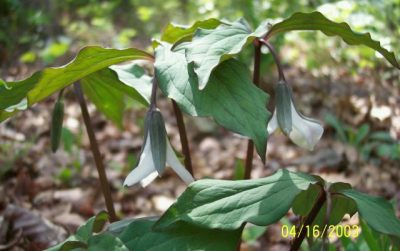
Catesby Trillium (Trillium catesbaei)
- SCIENTIFIC NAME: Trillium catesbaei
- PLANT TYPE: Perennial
- SCIENTIFIC NAME PRONUNCIATION: TRIL-ee-um KAYTS-bee-eye
- TAGS: Plant Tags: spring ephemeral. Plant Types: Perennial.
Catesby Trillium (Trillium catesbaei) grows in average to humusy but well-drained soil in light to deep shade; flowers point down or sideways and appear more prominent planted in groups of three or more or on slopes above a path; established plants prefer a summer dry period. Transplant tips: Relatively easy to transplant; dig about six inches deep to lift rhizomes...
read more

Chalk maple (Acer leucoderme)
- SCIENTIFIC NAME: Acer leucoderme
- PLANT TYPE: Tree
- SCIENTIFIC NAME PRONUNCIATION: (AY-ser loo-koh-DER-mee)
- TAGS: Plant Tags: good fall color and specimen tree. Plant Types: Tree.
Sun to shade; moist to moderately dry well-drained soil; shallowly rooted; acid to slightly alkaline soil. Easy to recognize in winter because many leaves remain on the tree. Other Common Names: Whitebark maple Other Scientific Names: Acer saccharum, Saccharodendron leucoderme
read more
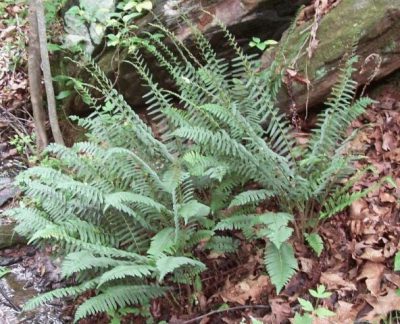
Christmas fern (Polystichum acrostichoides)
- SCIENTIFIC NAME:
- PLANT TYPE: Fern
- SCIENTIFIC NAME PRONUNCIATION:
- TAGS: Plant Tags: drought tolerant and evergreen. Plant Types: Fern.

Cinnamon Fern (Osmunda cinnamomea)
- SCIENTIFIC NAME: Osmunda cinnamomea)
- PLANT TYPE: Fern
- SCIENTIFIC NAME PRONUNCIATION: os-MUN-duh sin-uh-MOH-mee-uh
- TAGS: Plant Tags: specimen and wetland. Plant Types: Fern.
Cinnamon Fern (Osmunda cinnamomea) thrives in partial shade, but with more water it can take nearly full sun; long-lived perennial; moist, humus-rich acid soil. This fern is unmistakable when fertile fronds are present, but may be confused for other ferns when not.
read more

Coral bells (Heuchera americana)
- SCIENTIFIC NAME: Heuchera americana
- PLANT TYPE: Perennial
- SCIENTIFIC NAME PRONUNCIATION: HEW-ker-a a-mer-ih-KAY-na
- TAGS: Plant Tags: evergreen. Plant Types: Perennial.
Coral bells (Heuchera americana) grows in part shade to shade; acid, rich, rocky soil; moist to dry soil conditions. The root is thick and almost woody. Over time a population can grow to a ground cover effect. Note: Can be confused with Tiarella (Foam Flower) when not in bloom; both are in the Saxifragaceae family. In the nursery trade the two plants are hybridized...
read more

Coral honeysuckle (Lonicera sempervirens)
- SCIENTIFIC NAME: Lonicera sempervirens
- PLANT TYPE: Vine
- SCIENTIFIC NAME PRONUNCIATION: lah-NISS-ser-ruh sem-per-VYE-renz
- TAGS: Plant Tags: early bloom, evergreen, Hummingbirds, and larval host plant. Plant Types: Vine.
Twining vine with prominent blooms for full sun. Great for arbors but supports must be slender enough to twine around. Other Common Names: Trumpet honeysuckle; Woodbine (which is also a common name for Virginia creeper).
read more
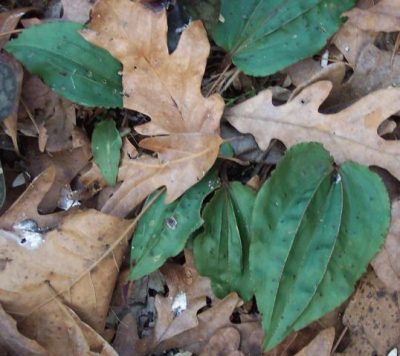
Cranefly Orchid (Tipularia discolor)
- SCIENTIFIC NAME: Tipularia discolor
- PLANT TYPE: Perennial
- SCIENTIFIC NAME PRONUNCIATION: tip-YOO-lar-ee-uh DIS-kol-or
- TAGS: Plant Tags: evergreen and orchid. Plant Types: Perennial.
Cranefly Orchid (Tipularia discolor) is found in every county in Georgia; the best time to locate this orchid is during a stroll in the winter woods after trees shed their leaves and the orchid sends up its wrinkled leaf. Thrives best in partial shade to shade; humus-rich damp soil, but is not especially particular about it. Transplant tips: Roots are fleshy,...
read more

Crossvine (Bignonia capreolata)
- SCIENTIFIC NAME: Bignonia capreolata
- PLANT TYPE: Vine
- SCIENTIFIC NAME PRONUNCIATION: (big-NO-nee-uh kap-ree-oh-LAH-tuh)
- TAGS: Plant Tags: butterflies, early flowers, evergreen, and hummingbird. Plant Types: Vine.
Partial shade to full sun; not particular about soil; will spread by root sprouts if not managed; plant at the base of a tree or fence; vine will climb to find sunlight. Showy blooms attract hummingbirds; semi-evergreen leaves add interest in winter; several cultivars available in nursery trade.
read more

Dimpled trout lily (Erythronium umbilicatum)
- SCIENTIFIC NAME: Erythronium umbilicatum
- PLANT TYPE: Perennial
- SCIENTIFIC NAME PRONUNCIATION: er-ih-THROH-nee-um um-BIL-i-ca-tum
- TAGS: Plant Tags: spring ephemeral. Plant Types: Perennial.
Dimpled trout lily (Erythronium umbilicatum) grows in shade to partial shade; does best in hardwood forest-like settings with rich soil and filtered light in spring; quick to establish in slightly moist areas and on creek banks. Transplanting tips: Plant, especially flower, quite fragile; bulb of mature (two leaf and flowering) specimen can be up to 18 inches deep...
read more
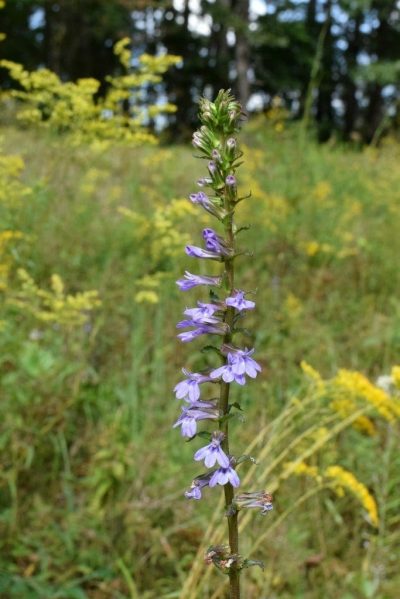
Downy Lobelia (Lobelia puberula)
- SCIENTIFIC NAME: Lobelia puberula
- PLANT TYPE: Perennial
- SCIENTIFIC NAME PRONUNCIATION: low-BEE-lee-uh pub-ER-uh-luh
- TAGS: Plant Tags: summer. Plant Types: Perennial.
Downy Lobelia (Lobelia puberula) grows in sun to partial shade; prefers consistent moisture.
read more

Downy rattlesnake plantain (Goodyera pubescens)
- SCIENTIFIC NAME: Goodyera pubescens
- PLANT TYPE: Perennial
- SCIENTIFIC NAME PRONUNCIATION: GOOD-yer-uh pew-BES-senz
- TAGS: Plant Tags: evergreen and orchid. Plant Types: Perennial.
Downy rattlesnake plantain (Goodyera pubescens) grows in humus-y, well-drained soil; does well in shade to partial shade. An excellent evergreen ground cover plant, but only spreads slowly. Other Common Names: Adder’s Violet Other Scientific Names: Epipactis pubescens, Epipactis willdenovii, Neottia pubescens, Orchiodes pubescens, Peramium pubescens, Tussaca...
read more

Downy Serviceberry (Amelanchier arborea)
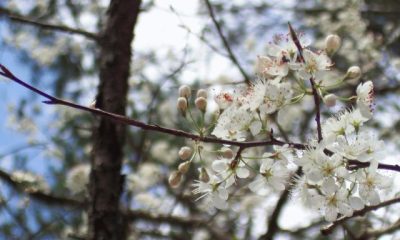
Downy serviceberry (Amelanchier arborea)
- SCIENTIFIC NAME: Amelanchier arborea
- PLANT TYPE: Tree
- SCIENTIFIC NAME PRONUNCIATION: (am-uh-LAN-kee-er ar-BOR-ee-uh)
- TAGS: Plant Tags: birds and edible. Plant Types: Tree.
Sun to shade; moist to dry well-drained soil; acid soil. The more sun the better the flowering and fruit potential. Other Common Names: Common serviceberry, Juneberry, Junebush, shadbush, shadblow, sarvisberry.
read more
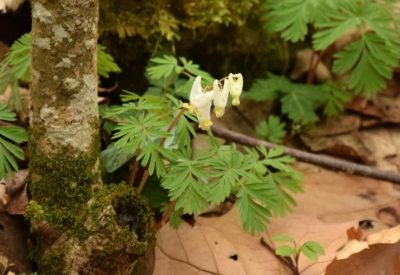
Dutchman’s breeches, blue staggers (Dicentra cucullaria)
- SCIENTIFIC NAME: Dicentra cucullaria
- PLANT TYPE: Perennial
- SCIENTIFIC NAME PRONUNCIATION: dye-SEN-truh kew-kew-LAR-ee-uh
- TAGS: Plant Tags: blue staggers and Dutchman's breeches. Plant Types: Perennial.
Cultural notes: Sometimes known as blue staggers because of its narcotic and occasionally lethal effects on grazing cattle The species is a spring ephemeral. In summer’s heat, the leaves turn yellow and disappear, to re-emerge the following spring from a bulb-like corm.
read more

Dwarf pawpaw (Asimina parviflora)
- SCIENTIFIC NAME: Asimina parviflora
- PLANT TYPE: Shrub
- SCIENTIFIC NAME PRONUNCIATION: (a-SEE-mee-nuh par-VEE-flor-uh)
- TAGS: Plant Tags: edible and host plant. Plant Types: Shrub.
Partial shade to sun; needs moist, well-drained soil; must have more than one plant for fruit to develop (cross-pollination). Edible fruit; larval food plant of zebra swallowtail butterfly. Other Common Names: Smallflower Pawpaw, Small-Fruited Pawpaw, Small Custard-Apple, Custard-Banana
read more
Page 2 of 7

